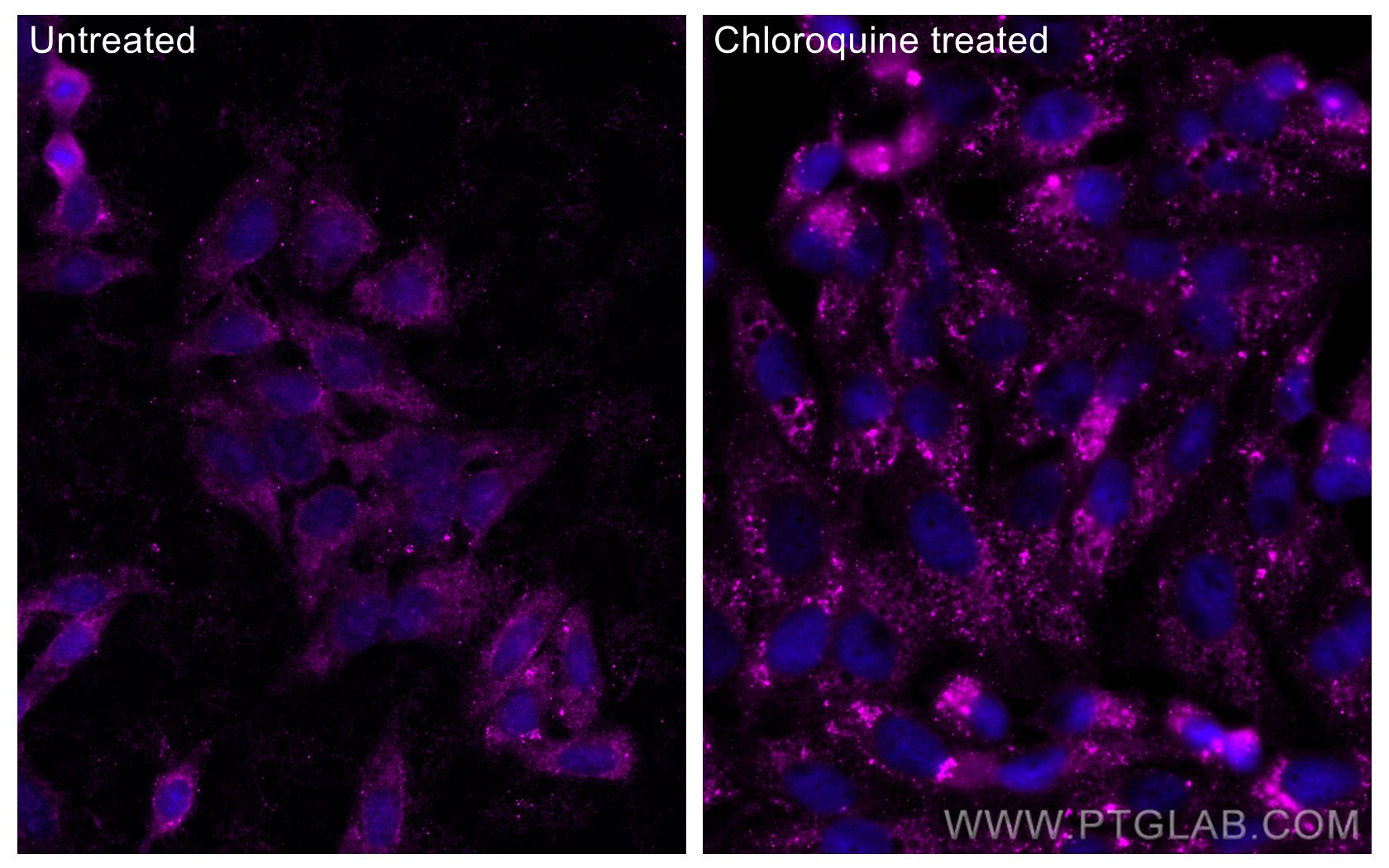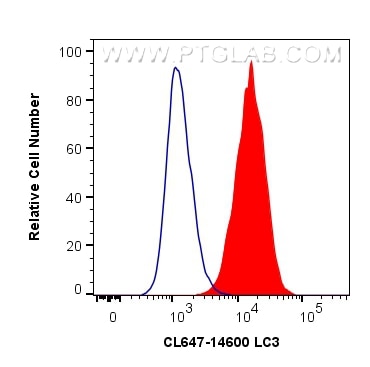Tested Applications
| Positive IF/ICC detected in | Chloroquine treated HepG2 cells |
| Positive FC (Intra) detected in | HeLa cells |
Recommended dilution
| Application | Dilution |
|---|---|
| Immunofluorescence (IF)/ICC | IF/ICC : 1:50-1:500 |
| Flow Cytometry (FC) (INTRA) | FC (INTRA) : 0.40 ug per 10^6 cells in a 100 µl suspension |
| It is recommended that this reagent should be titrated in each testing system to obtain optimal results. | |
| Sample-dependent, Check data in validation data gallery. | |
Product Information
CL647-14600 targets LC3 in IF/ICC, FC (Intra) applications and shows reactivity with human, mouse, rat samples.
| Tested Reactivity | human, mouse, rat |
| Host / Isotype | Rabbit / IgG |
| Class | Polyclonal |
| Type | Antibody |
| Immunogen |
CatNo: Ag6144 Product name: Recombinant human LC3 protein Source: e coli.-derived, PGEX-4T Tag: GST Domain: 1-125 aa of BC067797 Sequence: MPSEKTFKQRRTFEQRVEDVRLIREQHPTKIPVIIERYKGEKQLPVLDKTKFLVPDHVNMGELIKIIRRRLQLNANQAFFLLVNGHSMVSVSTPISEVYESEKDEDGFLYMVYASQETFGMKLSV Predict reactive species |
| Full Name | microtubule-associated protein 1 light chain 3 beta |
| Calculated Molecular Weight | 15 kDa |
| GenBank Accession Number | BC067797 |
| Gene Symbol | LC3B |
| Gene ID (NCBI) | 81631 |
| ENSEMBL Gene ID | ENSG00000140941 |
| RRID | AB_2920226 |
| Conjugate | CoraLite® Plus 647 Fluorescent Dye |
| Excitation/Emission Maxima Wavelengths | 654 nm / 674 nm |
| Form | Liquid |
| Purification Method | Antigen affinity purification |
| UNIPROT ID | Q9GZQ8 |
| Storage Buffer | PBS with 50% glycerol, 0.05% Proclin300, 0.5% BSA, pH 7.3. |
| Storage Conditions | Store at -20°C. Avoid exposure to light. Stable for one year after shipment. Aliquoting is unnecessary for -20oC storage. |
Background Information
Map1LC3, also known as LC3, is the human homolog of yeast Atg8 and is involved in the formation of autophagosomal vacuoles, called autophagosomes. Three human Map1LC3 isoforms, MAP1LC3A, MAP1LC3B, and MAP1LC3C, undergo post-translational modifications during autophagy. And they differ in their post-translation modifications during autophagy. Map1LC3 also exists in two modified forms, an 18 kDa cytoplasmic form that was originally identified as a subunit of the microtubule-associated protein 1, and a 14-16 kDa form that is associated with the autophagosome membrane. This antibody can cross react with MAP1LC3A, MAP1LC3B, and MAP1LC3C.
Protocols
| Product Specific Protocols | |
|---|---|
| FC protocol for CL Plus 647 LC3 antibody CL647-14600 | Download protocol |
| IF protocol for CL Plus 647 LC3 antibody CL647-14600 | Download protocol |
| Standard Protocols | |
|---|---|
| Click here to view our Standard Protocols |
Reviews
The reviews below have been submitted by verified Proteintech customers who received an incentive for providing their feedback.
FH Luthvia (Verified Customer) (09-29-2025) | CoraLite® Plus 647-conjugated LC3 Polyclonal antibody showed high sensitivity, and gave clear visualization of the target protein with low background
|






